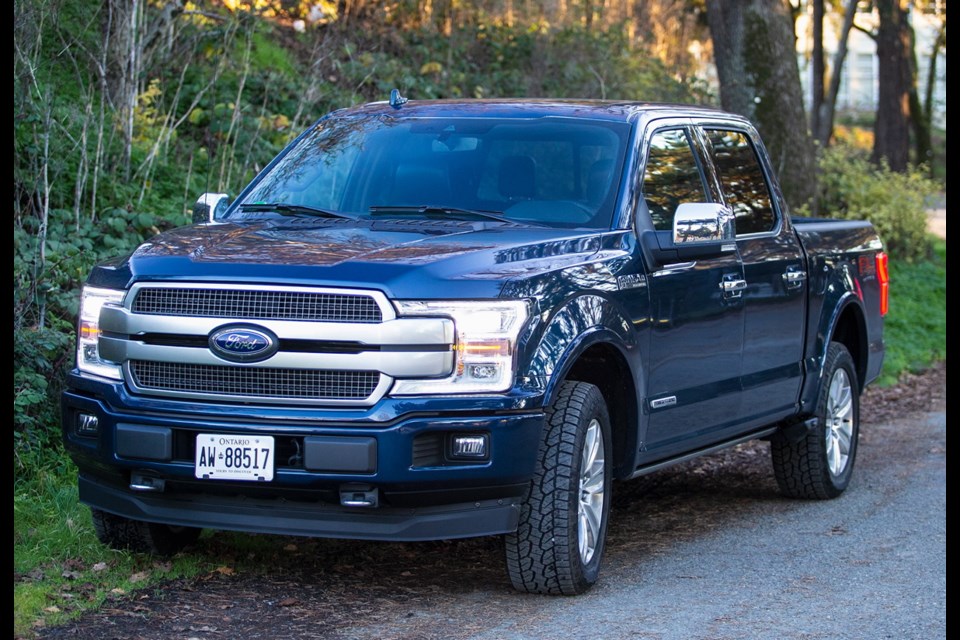The introduction of a turbocharged V-6 diesel into the 2018 Ford F-150 is guaranteed to bring smiles to people who typically haul with their rigs.
The Big 3 — Ford, GM and Ram — pride themselves on offering a wide assortment of vehicles for their many buyers.
The Ford F-150 is the gorilla in the room, dominating the number one list for more years than competitors would care for.
Consequently, they are always looking for an opportunity to tempt buyers away from Ford.
Ram did that, offering buyers a choice of a 3.0-litre V-6 turbodiesel. The response was immediate, and the reason for today’s review.
Ford is no stranger to diesels: It has been putting Power Stroke diesel V-8s under the hoods of its trucks for ages. But it has been reserving that more for its heavy-duty versions — the F-250 and F-350 models.
Ford’s new 3.0-litre V-6 turbodiesel finally bestows a compression-ignition engine worthy of the Power Stroke label to the half-ton pickup segment.
I drove a crew-cab F-150 Platinum 4X4 for this review.
The F-150 is available with three engines, with the trusty 5.0-litre V-8 as the primary engine. Buyers can also choose between a 3.5-litre turbocharged V-6 or the new 3.0-litre turbodiesel.
The new engine has quite the pedigree. It was developed with PSA Peugeot Citroen (who knew?) and a version of the engine powers some Land Rovers in Europe. It is manufactured in Ford’s U.K. engine plant.
The engine block is crafted out of compacted graphite iron with aluminum heads and a forged-steel crankshaft. It produces 250 horsepower at 3,250 rpm and 440 lb.-ft. of torque at 1,750 rpm.
(Do you find it surprising that the Ram 3.0-litre diesel is rated at 240 hp and 420 lb.-ft. of torque?)
Needless to say, you can expect Ram to respond to Ford’s one-upmanship very soon.
For now, Ford can claim best-in-class towing at 5,170 kilograms (11,400 lbs.) and an 880-kilogram (1,940 lbs.) payload. Maximum payload depends on the model and specific axle ratios you choose, of course.
The engine is mated to a 10-speed automatic transmission with gears specific to the diesel power curve. (The transmission has a Tow-Haul mode.)
It is interesting to note that Ford’s other engine, the twin-turbo 3.5-litre V-6, is actually more powerful (375 hp and 470 lb-ft. of torque). While it will perform better, the diesel’s trump card will be its fuel economy over the gasoline powerplant — especially if you factor in the cost of premium fuel, if you are looking at peak performance for the gas engine.
The 3.0-litre (equipped with 4x4) is rated at 11.8 city and 9.3 litres per 100 km on the highway.
Before you go rushing down to the Ford store, you might pause when you find out the price of the diesel engine option — a $5,650 to $7,500 upcharge depending on model chosen.
Even if that doesn’t slow you down, it might when you find out that you can’t order it on lesser F-150s: It is only available on Lariat and higher trim models.
On the Lariat it is $7,500 more, on the Platinum, my tester, it is a $5,650 premium.
The engine does sell itself. Gone is the wait to let glowplugs warm up to start the compression-ignition engine — the engine turns over with just a moment’s hesitation. Gone is the clatter when cold and puffs of black smoke. In its place is no auditory evidence of a diesel engine’s existence.
There isn’t even a whiff of diesel exhaust. The only reminder is the smell of the fuel on your hands if you forget to pack a pair of gloves when refuelling the tank.
If you plan to tow large objects over long distances, you will be sure to arrive relaxed, as the cabin is as quiet as a passenger car. You get all of the creature comforts as well, with heated and ventilated leather seats. The crew cab is very comfortable for up to five adults.
My tester had a full-size moonroof and active park technology (including a 360-degree camera).
With such a large premium over the stock engine, Ford doesn’t expect to sell tons of the 3.0-litre V-6 diesels. It is really an opportunity to plug a hole in its lineup and win back customers who might have run off to Ram.
The engine, however, may likely turn up in two new Ford products about to be launched — the new mid-sized Ranger and the upcoming Bronco.
Despite diesels disappearing on passenger cars, its future powering trucks is all but certain. Expect to see more of this engine in the years ahead.
THE SPEC SHEET
Type: Full-size pick-up front engine, 4x4
Engine: Turbocharged 3.0-litre V-6, 250 hp at 3,250 r.p.m. and 440 lb.-ft. of torque at 1,750
Transmission: 10-speed automatic
Dimensions (mm): Length, 5,316; width, 2,029; height, 1,918; wheelbase, 3,109
Curb weight (kg): 2,012
Price (base/as tested): $71,579/ $86,129 (includes $1,800 freight and PDI and $100 AC tax)
Options: 3.0-litre turbodiesel $5,650, moonroof $1,750, floor mats $170, adaptive cruise with tow package $1,750, FX4 off-road package $750, box side steps $500, technology package with park assist $1,350, wheel well liner $180, spray in bed liner $550
Tires: 275/55 R20 all-terrain
Fuel type: Diesel
Fuel economy (L/100km): 11.8 city/ 9.3 highway
Warranty: Three years/60,000 km new vehicle, five years/100,000 km powertrain and roadside assistance



